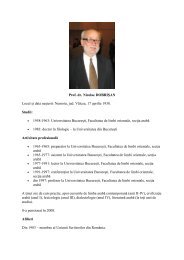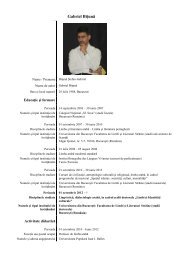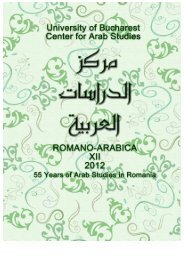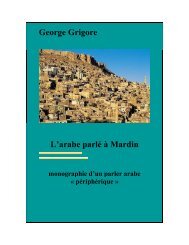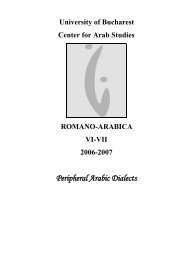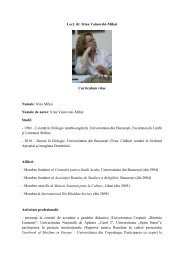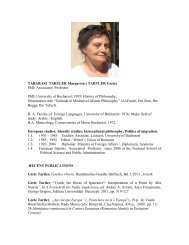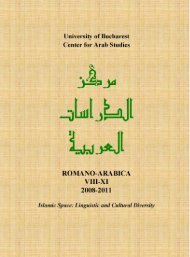Arabic Linguistics
Arabic Linguistics
Arabic Linguistics
You also want an ePaper? Increase the reach of your titles
YUMPU automatically turns print PDFs into web optimized ePapers that Google loves.
VI. Sentential predicates:<br />
The grammarians were also interested in constructions with kāna, or any of<br />
its sisters, where the predicate is a nominal sentence (ğumla ismiyya). 18 The model<br />
sentence here is:<br />
20. kāna Zaydun abūhu qā‟imun,<br />
where the nominal sentence abūhu qā‟imun occurs after kāna and its noun.<br />
There are two other possibilities in which the order of the nominal sentence itself is<br />
preserved:<br />
21. kāna abūhu qā‟imun Zaydun<br />
22. abūhu qā‟imun kāna Zaydun.<br />
If that order, however, is not preserved, the resulting sentence will then be: 19<br />
23. qā‟iman kāna Zaydun abūhu.<br />
Sentences 21 and 22 are said to have no parallels in actual usage. As a<br />
result, they are both controversial since the grammarians had to resort to<br />
argumentation in order to accept or refuse them. For sentences 23, see VII below.<br />
VII. Predicate complements:<br />
The complexity of the constructions discussed by the grammarians is<br />
increased further when they introduce a complement after the predicate of kāna or<br />
its sisters – what they call ma„mūl al-hàbar. The first possibility is to separate<br />
between the predicate and its complement by kāna and its noun. We can identify<br />
from the sources four different constructions of this type:<br />
23. qā‟iman kāna Zaydun abūhu<br />
24. ākilan kāna Zaydun t}a„āmaka<br />
25. rāġiban kāna Zaydun fīka<br />
26. musāfiran kāna Zaydun al-yawma.<br />
The first sentence is obviously conjectural and it is said to be impermissible<br />
because abūhu cannot be separated from the noun that governs it, qā‟iman, due to<br />
their interrelatedness. This, however, is not the case in the second sentence where<br />
the complement, or ma„mūl, is the direct object of ākilan and can therefore be<br />
separated from it. Sentences 25 and 26 are also admissible by all grammarians<br />
because the complement of the predicate is either a preposition or an adverb, and<br />
these do enjoy a considerable degree of flexibility in their syntactical position.<br />
Another possibility of word order is to begin with kāna followed by the<br />
complement of the predicate. Based on whether the third element is the noun of<br />
kāna or its predicate, the following two constructions may be considered:<br />
27. kāna t}a„āmaka Zaydun ākilan<br />
28. kāna t}a„āmaka ākilan Zaydun.<br />
The first sentence is admissible by the Kufans, but not by the Basrans,<br />
whereas the second sentence is admissible by the Kufans and some Basrans,<br />
45



